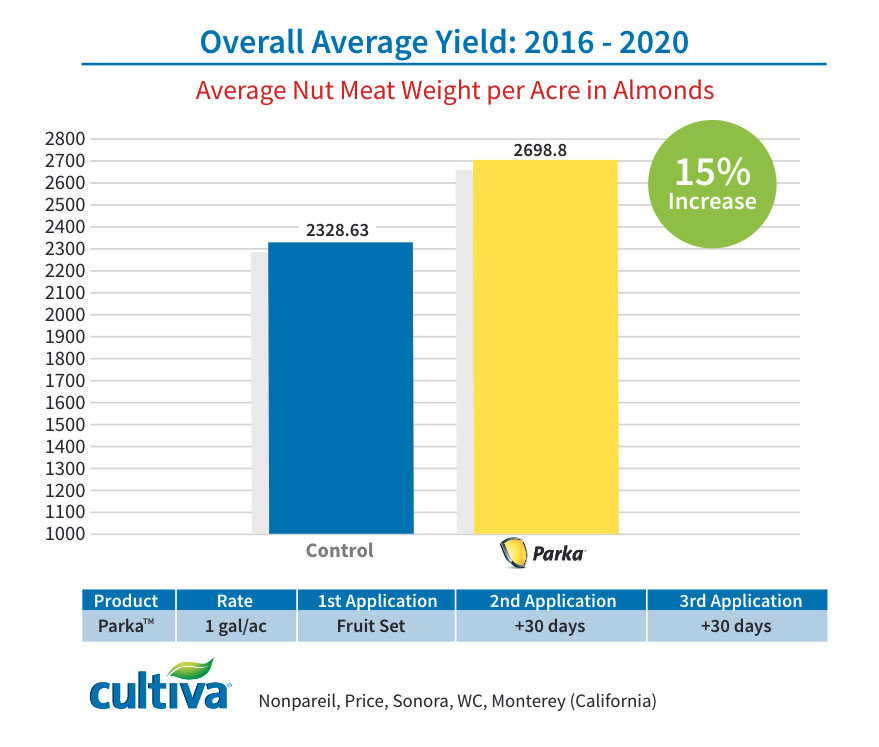Supplementing the Cuticle for Healthier Trees and Fewer Dropped Fruit
Heat stress due to rising atmospheric temperatures is becoming one of the main limiting factors to crop productivity. High temperatures can negatively affect plant growth and development and reduce overall yields and decrease nut quality. During the heat stress periods, leaf stomata can shut down in an effort to conserve water, slowing photosynthesis, which in turn translates to less support for leaves and nuts. Parka is proven to supplement and strengthen the cuticle of both foliage and nuts. By reinforcing the cuticle with a clear, hydrophobic, and elastic lipid bilayer, Parka reduces water loss from evaporation, and provides better resistance to heat stress. A healthier, less-stressed tree can support more nuts – all the way to harvest.
Additionally, when applied in a program, Parka has shown to increase overall better tree performance. Paired with a reduction in ethylene production during the season, this results in healthier plants and better nut retention. In walnuts, Parka applications have also demonstrated a significant reduction in sunburn without leaving the visible residue usually seen with mineral-based coatings.

Why use Parka on Nut Crops?
- Decreases fruit drop and increases yield by 10% over the control.
- Reduces impact of water and heat stress on trees.
- Provides sunburn protection on walnuts.
- Easily tank mixed with foliar nutrients and pesticides.
- Exempt from maximum residue levels.
- Zero preharvest interval, zero worker reentry interval
Download Resources
How to Use Parka in a Program
In almonds, to reduce fruit drop and protect the tree from environmental stress, Parka applications should start after nut set (late March) and repeated every 30 days for a total of 3 applications.
In walnuts and pistachios, to reduce nut drop and protect against sunburn, Parka applications should start after nut set (late May-early June) and repeated every 30 days for a total of 3 applications.
FAQ
What Causes Fruit Drop in Nut Crops?
There are many reasons why fruit drop happens in nut crops. Early fruit drop, shortly after bloom, can happen naturally to eliminate malformed or improperly pollinized fruitlets. On the other hand, later season drops can be the result of competition for available resources or caused by environmental factors such as poor nutrient availability, drought, or heat stress. These environmental stresses reduce the plant’s ability to photosynthesize and create the energy needed to develop the fruit, so it responds by aborting the fruit it cannot support. Ultimately, this can impact harvest yields.

How Does Parka Reduce Fruit Drop?
Parka applications reduce the negative impacts of environmental stress by increasing the antioxidant defense. This reduces oxidative molecules that degrade cell membranes and negatively affect cell function Additionally, Parka increases chlorophyll and pheophytin concentration in the leaves––both are critical in photosynthesis. This has been proven by observing better net CO2 exchange and transpiration rates in Parka-treated trees.
Furthermore, Parka has been shown to reduce ethylene production during the season; this is key for fruit drop prevention since this PGR is responsible for the production of enzymes that trigger fruit abscission. Ultimately, Parka-treated trees have a better adaptation to environmental stress conditions and overall tree performance. This translates to healthier trees capable of retaining more yield.
What Do Growers Like About Parka?
Reducing fruit drop keeps more profit in growers’ pockets. Parka can be tank mixed with a wide variety of other foliar inputs, including both fertilizers and pesticides. This saves the fuel and labor costs of additional passes in the field. If Parka is applied for sunburn protection in walnuts, it is superior to kaolin clay or calcium carbonate sprays, because crop protection products can be applied afterwards.
Parka’s excellent worker safety profile, a zero pre- and post-harvest interval, and exemption from maximum residue levels are also major advantages for growers.


